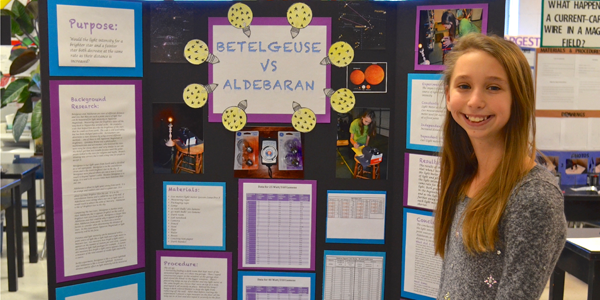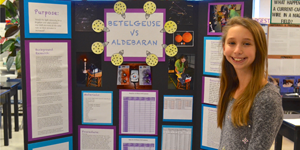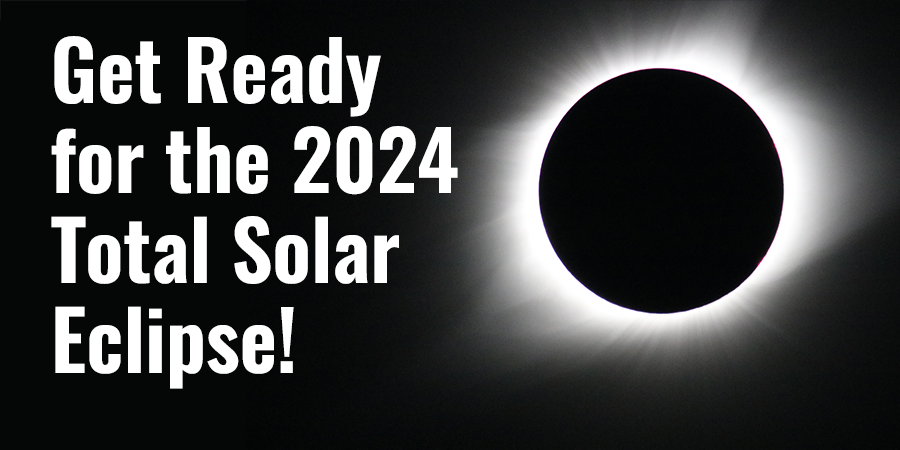Going the Distance with Starlight Science
This sixth grade student is blazing a path in astroscience with a string of successful science projects that are out of this world and yet amazingly down to Earth. With this year's project, she took a comparative look at the change in intensity of a star's light in relation to its distance. She spent a lot of time gathering light meter readings and ended up with a winning combination of math and physics!

While every student can and should do and enjoy hands-on science, some students just have it in them, the extra spark and drive that sends K-12 science education skyrocketing. These students thrive on the science fair project experience. These students, like Brittany Wenger and Jack Andraka, pursue projects with the power and potential to revolutionize their fields of interest. These students are not intimidated by the fact that they are, after all, students. Ashleigh Nicoll, a studen in North Carolina, is clearly such a student, and with her fourth successful school science fair project, Ashleigh continues to channel her interest in space science into a stream of stellar projects that are at once astronomical in scope and yet contained in real-world, down-to-Earth practical procedures.
When Ashleigh and her family first contacted Science Buddies last year, she was working on her third astronomy-focused science fair project. In learning more about Ashleigh and her history with science fair, we shared a wonderful story about the spelling bee that first inspired her interest in astrophysics. Since then, Ashleigh has continued charting her own course of astronomy projects and space science exploration.
Bringing Space-sized Science Questions Down to Scale
Elementary and middle school science fair projects often require hands-on experimentation, a procedure for which you can run trials, gather data, and provide results. This approach can be a challenge when it comes to space science. Once you move beyond early elementary school astronomy experiments, many space-oriented projects become more data-driven and center around data analysis using publicly available data sets.
In fifth grade, Ashleigh created her own project design to explore satellites Juno and Cassini in a concrete way using baking sheets, marbles, and paint. Science Buddies later created the Satellite Science: How Does Speed Affect Orbiting Altitude? astronomy science project inspired by Ashleigh's project.
This year, as a sixth grade student, Ashleigh decided to explore the light intensity of stars relative to their distance. Giving specificity to her exploration, Ashleigh chose to anchor her project on the Betelgeuse and Aldebaran stars. Betelgeuse is the red star in the Orion constellation, the ninth brightest star in the night sky, and appears as the center star in a formation known as the Winter Circle. Aldebaran also appears as one of the five stars that make up the ring (or hexagon) of the Winter Circle, but Aldebaran may be best known as the bright "eye" of the constellation Taurus—the "Bull's Eye" star.
Ashleigh says she picked these stars because she had previously studied them for the Science Olympiad. "Those two stars made me laugh every time I said their names," she says, a comment that brings to mind her intrinsic love of words and the spelling bee that launched her into space science. "My project was called 'Betelgeuse vs Aldebaran,'" says Ashleigh. "As you can tell, I like the 'vs.' theme." (Her previous projects were: "Juno vs Cassini," "Earth vs Apophis," and "Bouncy Ball vs The Moon.")
Ashleigh built her project around the foundation of the Star light, Star bright: How Does Light Intensity Change with Distance? Science Buddies Project Idea. In that project, students use a single light bulb experiment to test whether light from a point (like a star) follows the inverse-square law in terms of its brightness relative to its distance. In other words, as the light moves away, does the intensity of the light follow a set mathematical pattern that can be correlated to the distance. Understanding this, of course, is central to being able to tell how far away individual stars are from the Earth based on their brightness.
Ashleigh customized her project by focusing on two stars, represented by light bulbs of different wattages, a 25-watt bulb for Aldebaran and a 40-watt bulb for the brighter Betelgeuse. (Aldebaran is 65.23 light years from Earth. Betelgeuse is 642.5 light years from earth.) Through her project, Ashleigh was trying to show that even though the stars differ in brightness, they will follow the same mathematical formula and decrease in light intensity at the same rate as they move farther away. As part of her exploration, she took light meter readings of each bulb as she moved farther away at set distances. Her light meter, however, provided readings of Exposure Value (EV), and Ashleigh needed measurements in Lux. "I did a whole lot of math to convert the readings to Lux," says Ashleigh.
Ultimately, the math required by her project was the biggest challenge. "Some of the equations were crazy for me, but I figured out every one of them by hand," says Ashleigh. "My mom has a friend who worked for NASA and he showed me how to use Excel to plug in my data and create a spreadsheet. That was really cool, and I used it to check my work, but I wanted to see how each equation came out on my own. The inverse square law was really interesting. I had fun figuring out how it worked with my data."
Despite the challenge of the numbers, Ashleigh had a great time running her experiment in the garage and collecting her data. "The most exciting part of my project was doing the actual project. It took forever to collect all the data, but I really enjoyed turning off the lights and checking the light meter at each 6-inch mark! It was exciting not knowing what the light meter would say."
Having moved up to middle school competition, Ashleigh increased her data gathering this year, giving her a larger statistical pool from which to analyze her results and draw conclusions. With more than 300 students participating in her school science fair, it was a different experience than elementary school, but once again Ashleigh moved ahead and showed her project at the regional science fair. It was her fourth trip to the regional fair, but Ashleigh admits that this year, competing as a middle school student, was a very different experience.
"The projects in the physics category were amazing and intimidating. I loved talking with the other students about their work." Ashleigh took home a 3rd place award. Unfortunately, only 1rst and 2nd place category winners move on to the state-wide North Carolina Science and Engineering Fair. Ashleigh was disappointed, but she already has her sights set on next year's science fair season.
Celebrating Student Science
Ashleigh's success at science fair, her piercing interest in astroscience, and her keen following of the work of Dr. Neil DeGrasse Tyson has not gone unnoticed in her community. Last fall, Ashleigh was invited to give a speech at the State Chamber of Commerce Annual Education Summit. She talked about three of her previous school science projects, the value of science fair, and the importance of teachers she has had. "There were over 200 people at the meeting," recalls Ashleigh, "and I got to explain my projects to Congresswoman Virginia Foxx, the NC Superintendent of Schools Dr. June Atkinson, and I even talked with Governor McCrory."
Quenching her thirst for astrophysics and space science is certainly a challenge in the classroom scenario. Ashleigh and her family are proactive about looking for avenues to feed her interest in space science and keep her aware of news and developments in space science.
"I recently got a Twitter account, and I follow NASA, the International Space Station, and all the astronauts aboard the Space Station. I really enjoy Astronaut Terry Virts photographs and posts! I am also following Astronaut Scott Kelly very closely, too! I have learned so much from the tweets, articles, and videos they post. I am also very excited that Dr. Neil DeGrasse Tyson is coming back to Raleigh in October. My mom got us tickets to see him speak. The last time I saw him I was a 3rd grader!!"
"I wish we did more on space in middle school, because it really fascinates me," says Ashleigh. "I read a lot of books on space, so that helps." But when it comes to classroom assignments, Ashleigh's level of interest may, understandably, be light-years away.
"We are currently doing a unit on space in school and have to do research on a space topic. How do you pick just one? It took me forever to decide! I am doing a PowerPoint presentation on future space missions. I am really excited about this topic!"
For Ashleigh, every speck of space science counts.
"I even built the 'LEGO Women in Science' kit and put it on my desk. The kit has a woman astrophysicist in it! I love it!"
Making Connections
To learn more about Ashleigh and her journey with space science (and the spelling bee that started it all), see: Galactic Curiosity: Fifth Grade Student Charts a Science Course for the Stars. For other inspiring student success stories, visit the Science Buddies in Action area.
To get started with your own space science exploration, we recommend you check out projects like these from our astronomy area:
- Satellite Science: How Does Speed Affect Orbiting Altitude?
- Craters and Meteorites
- What Makes the Rings of Saturn?
- Catching Stardust
- Star light, Star bright: How Does Light Intensity Change with Distance?
- Dirty Snowballs: How a Comet's Size Affects How Fast It Melts
- The Milky Way and Beyond: Globular Clusters
- Finding the Center of the Milky Way Galaxy Using Globular Star Clusters
- Correlation of Coronal Mass Ejections with the Solar Sunspot Cycle
- Sunspot Cycles
- Asteroid Mining: Gold Rush in Space?
- NASA Asteroid Database: What Can You Learn About Our Solar System?
- The Measure of Mercury: Analyzing Impact Craters on the Innermost Planet
- X-Ray Vision: Seeing Into Space
Many projects and questions related to space science are related to the analysis of data from big data sets. For more information on student science projects involving big data, see Explore the World of Big Data with Your Science Project.
Science Buddies Project Ideas and resources in Astronomy are supported by Northrop Grumman.
Categories:
You Might Also Enjoy These Related Posts:
- Plastics and Earth Day - Science Projects
- Arduino Science Projects and Physical Computing
- 10+ Robotics Projects with the BlueBot Kit
- 5 STEM Activities with Marshmallow Peeps
- March Madness Basketball Science Projects: Sports Science Experiments
- Women in STEM! More than 60 Scientists and Engineers for Women's History Month
- Explore Artificial Intelligence and Machine Learning with Student AI Projects
- 10 Reasons to Do the Rubber Band Car Engineering Challenge










